Oxidation-Specific Epitopes (OSEs) Dominate the B Cell Response in Murine Polymicrobial Sepsis
- PMID: 32849533
- PMCID: PMC7412885
- DOI: 10.3389/fimmu.2020.01570
Oxidation-Specific Epitopes (OSEs) Dominate the B Cell Response in Murine Polymicrobial Sepsis
Abstract
In murine abdominal sepsis by colon ascendens stent peritonitis (CASP), a strong increase in serum IgM and IgG antibodies was observed, which reached maximum values 14 days following sepsis induction. The specificity of this antibody response was studied in serum and at the single cell level using a broad panel of bacterial, sepsis-unrelated as well as self-antigens. Whereas an antibacterial IgM/IgG response was rarely observed, studies at the single-cell level revealed that IgM antibodies, in particular, were largely polyreactive. Interestingly, at least 16% of the IgM mAbs and 20% of the IgG mAbs derived from post-septic mice showed specificity for oxidation-specific epitopes (OSEs), which are known targets of the innate/adaptive immune response. This identifies those self-antigens as the main target of B cell responses in sepsis.
Keywords: B cell response; CASP; oxidation-specific epitopes; polymicrobial sepsis; polyreactive antibodies.
Copyright © 2020 Nicolai, Pötschke, Raafat, van der Linde, Quosdorf, Laqua, Heidecke, Berek, Darisipudi, Binder and Bröker.
Figures

 ), or sham surgery (▵). Mice that underwent CASP surgery are indicated by a black diamond (♦). Mean values of OD 450 nm are shown. Each symbol represents one animal (N = 5–18). Statistical analysis was done by One-way ANOVA with the Bonferroni post test for selected pairs. *p < 0.05, **p < 0.01, ***p < 0.001.
), or sham surgery (▵). Mice that underwent CASP surgery are indicated by a black diamond (♦). Mean values of OD 450 nm are shown. Each symbol represents one animal (N = 5–18). Statistical analysis was done by One-way ANOVA with the Bonferroni post test for selected pairs. *p < 0.05, **p < 0.01, ***p < 0.001.



References
-
- Fleischmann C, Hartmann M, Hartog CS, Welte T, Heublein S, Thomas-Rueddel D, et al. Epidemiology of sepsis in Germany: incidence, mortality and associated costs of care 2007-2013. Intensive Care Med Exp. (2015) 3(Suppl. 1):A50 10.1186/2197-425X-3-S1-A50 - DOI
Publication types
MeSH terms
Substances
LinkOut - more resources
Full Text Sources
Medical

